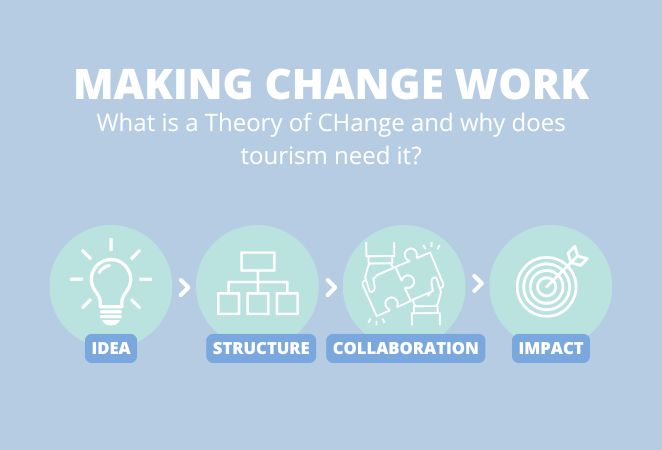The Theory of Change helps tourism stakeholders turn ambition into action. By creating a shared roadmap, it supports SMEs and governments in tackling complex sustainability challenges in areas like waste, water, and energy. In the 3ST project, it's the foundation for regional pilots and long-term collaboration
What is a Theory of Change and why does tourism need it?
Sustainability doesn’t happen overnight. It requires vision, structure, and collaboration. That’s why we use the Theory of Change (ToC) approach in the 3ST project, because it helps us translate big ambitions into concrete, realistic actions that work in practice.
But what is a Theory of Change exactly and why is it relevant for tourism?

What is a Theory of Change?
It’s a practical, visual tool that creates clarity in complex environments. Originally developed for social change initiatives, ToC is now widely used in sustainability, development and public policy. In 3ST, it supports our mission to strengthen sustainability skills in the tourism sector.
Why use it in tourism?
Tourism ecosystems are inherently complex. They involve a wide variety of stakeholders. From local governments, entrepreneurs, DMOs, environmental agencies, water boards, housing authorities, energy providers, and even more. Each with different priorities, policies and timelines.
This fragmentation makes it difficult to turn good ideas into lasting impact. Promising plans for more sustainable tourism often get stuck between different responsibilities, priorities, and levels of governance. The Theory of Change offers a solution. It creates a shared roadmap and common language that helps all stakeholders move in the same direction. It brings clarity by making visible:
- The common goals stakeholders share
- The steps needed to reach them
- The roles and responsibilities of each actor
- The underlying assumptions and risks that may affect outcomes
In short: it turns abstract ambitions into coordinated action.
What does it deliver?
Using ToC gives you:
- A shared vision that’s supported by all partners
- A clear plan of how to get there with defined milestones
- Insight into who to involve, and when
- A way to evaluate progress and adapt along the way
- Greater alignment between policy and practice
It also helps build trust and momentum. Essential for any sustainability transition.A Theory of Change is a method for planning and evaluating change. It helps you define your long-term goal and then map backwards: What needs to happen first? What assumptions do you rely on? Who do you need to involve? What actions will get you there?
For small and medium-sized enterprises in tourism, sustainability often feels overwhelming. Where do you start? What actions make a real difference? What fits your business?
By participating in a ToC process, entrepreneurs can:
- Gain clarity on where to focus their efforts (like waste, energy, water)
- See how their actions connect to a larger goal and how they can collaborate with others in their region
- Discover relevant support, funding and partnerships
- Share knowledge and challenges with peers
- Influence the direction of local sustainability initiatives
- Uncover assumptions that may be holding back progress, such as overestimating guest resistance or underestimating technical feasibility
Rather than working in isolation, SMEs become part of a bigger movement. Supported by others in their region.
Governments are key actors in enabling sustainable tourism. But coordinating change in fragmented landscapes can be hard. The ToC approach helps policymakers to:
- Identify shared priorities across departments and stakeholders
- Engage tourism actors in a structured, inclusive way
- Clarify which interventions are most impactful and realistic
- Monitor progress over time with clear indicators
- Build public support and political legitimacy
- Surface hidden assumptions, such as believing certain collaborations aren’t possible or that certain behaviours can't change, which often limit ambition
It also strengthens collaboration between levels of government (local–regional–national) and between sectors (e.g. waste, water, energy, mobility, housing).
A tested method in 3ST
In 3ST, each pilot region develops its own Theory of Change focused on tourism-related challenges in waste, water or energy. These ToCs are created through interactive workshops with local stakeholders and serve as the backbone for pilot implementation.
They ensure that every action we take is rooted in a shared understanding, and that we continuously learn and adapt as we go. Because in 3ST, we don’t just talk about sustainability. We build it together with all stakeholders in the region.

